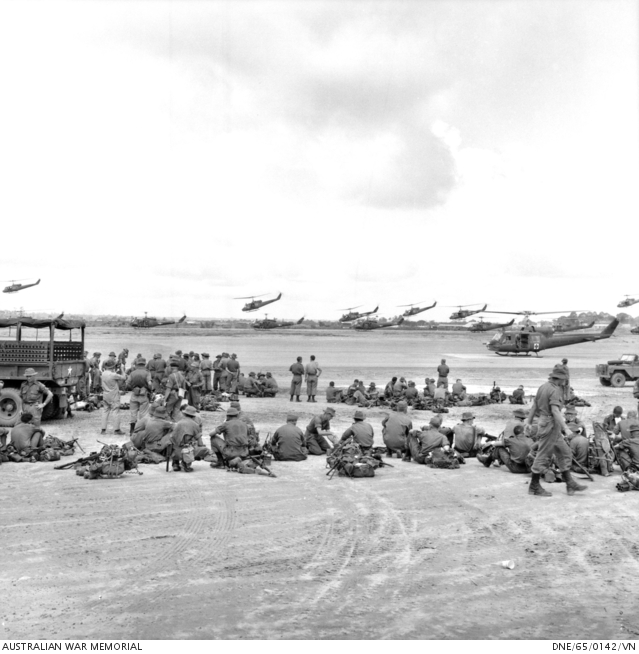50th Anniversary of the deployment of the first Australian combat troops to the Vietnam War
On 27 May 1965, a fast troopship, the converted aircraft carrier HMAS Sydney, departed Sydney on her first of over 20 voyages to South Vietnam, carrying 347 officers and men of the 1st Battalion, Royal Australian Regiment (1RAR) together with vehicles, equipment and stores. The remainder of the battalion flew by chartered Qantas 707 jets on secret overnight flights from Richmond airbase to Saigon over the following two weeks.
The dispatch of this unit, totaling some 1,100 Australian Regular Army troops, marked the first deployment of Australian combat troops to the struggling Republic of Vietnam. 1RAR was generally considered one of the most professional and best trained battalions ever to have left Australia, although deficiencies in its equipment and preparation would soon become apparent during extended operations in the bitter war in Vietnam.
Australian support for South Vietnam since the early 1960s was in keeping with the ‘forward defence’ policy of Australia and the ‘containment’ strategy of the United States, aimed at stemming the spread of communism in Southeast Asia.
The arrival of the Australian Army Training Team Vietnam (AATTV) in South Vietnam in July and August 1962 had signaled the beginning of Australia's military involvement in the Vietnam War.
By early 1965, when it appeared South Vietnam could no longer stave off the southern communist insurgents, the Viet Cong, and their North Vietnamese Army supporters, the United States commenced a major escalation of its military commitment to the war. By the end of the year it had sent 180,000 American troops to South Vietnam. As part of the build-up, the US government requested further support from friendly countries in the region, including Australia.
Following the arrival of the first American combat troops in Vietnam in March 1965, Prime Minister Menzies announced on 29 April the decision to commit an Australian infantry battalion.
The Australian government dispatched the 1st Battalion, Royal Australian Regiment (1RAR), in May 1965 to serve with the US 173d Airborne Brigade (Separate) in Bien Hoa and adjacent provinces as the elite American brigade’s third battalion. 1RAR was established in South Vietnam by June 1965 and served for twelve months under operational control of 173d Airborne Brigade, jointly located at the large Bien Hoa airbase 25 kilometres northeast of Saigon (present day Ho Chi Minh City).
Initially, 1RAR was restricted to security operations defending the airbase. However, in September 1965, the Australian government lifted these restrictions, and the unit was able to be deployed as a manoeuvre battalionThe battalion was expanded to a battalion-group of 1,400 men with the arrival of a further 350 men in support elements including an artillery battery, an engineer troop, an army aviation reconnaissance flight and medical and logistic support. The expanded battalion-group carried out deep patrolling and offensive and reaction operations with combined US forces in the nearby Viet Cong dominated base areas, War Zones C and D, and the Iron Triangle.
1RAR performed outstandingly on operations with the American brigade, notably during Operation Crimp in the Iron Triangle when the Australians breached the vast Cu Chi tunnel network and discovered an important Viet Cong headquarters complex.
Although Australian and American soldiers fought well together on operations, the Australians soon found themselves at odds with very different American doctrine and tactical principles to those they had learned in fighting a counter-insurgency war in Malaya. The Australians were skilled in small unit tactics aimed at pacification, the restoration of government control, separating the guerrillas from the population, searching, patrolling and ambushing, all concepts emphasising patience, stealth and economy of effort.
The American strategy was one of attrition, aiming to inflict such heavy losses on the communists that they would lose the will and ability to continue their insurgency struggle. They favoured the ‘direct approach’ in which they could bring their numbers, mobility and firepower to bear in order to kill large numbers of the enemy. ‘Body counts’ became the measure of success and the ‘search-and-destroy’ operation evolved as the principal tactic of American ground forces.
Between 1965 and the end of 1966, the rapid build-up of American forces in Vietnam to more than 280,000 personnel engaged in aggressive operations slowed the Communist advances and stabilised the situation in the country. Government control was restored and security was extended to some populated areas.
In March 1966 the Australian commitment was expanded to an independent task force of two battalions with combat and logistic support. Although the task force remained under American operational control, this arrangement enabled the Australians to operate more independently and to practise their own doctrine of counter-insurgency operations. The 1st Australian Task Force established its base at Nui Dat in the heart of the southern province of Phuoc Tuy, where it would remain from mid-1966 to the end of 1971.
The soldiers of 1RAR ended their tour of duty in June 1966 and returned to Australia. The battalion had suffered 23 soldiers killed in action, missing, or died of wounds and other causes; many more were wounded or injured on active service. Scores of soldiers were awarded British Imperial, American and Republic of Vietnam honours and decoration. The battalion was also recommended for a US Meritorious Unit Commendation and a Republic of Vietnam unit citation. On 8 June the soldiers of 1RAR proudly marched through the main streets of Sydney to a tumultuous welcome by 300,000 people.
Additional reading:
Bob Breen, First to Fight: Australian diggers, N.Z. Kiwis and U.S. paratroopers in Vietnam, 1965-66 (Allen & Unwin, Sydney, 1988)
Lex McAulay, The Fighting First: Combat Operations in Vietnam 1968-69, The First Battalion, The Royal Australian Regiment (Allen & Unwin, Sydney, 1991)
Ian McNeill, To Long Tan: The Australian Army and the Vietnam War, 1950-1966 (Allen & Unwin in association with the Australian War Memorial, Sydney, 1993)
Media Contact
Contact Name
Media team
Contact Email
Contact Phone Number
02 6243 4575
Contact Mobile Number
0409 600 038








